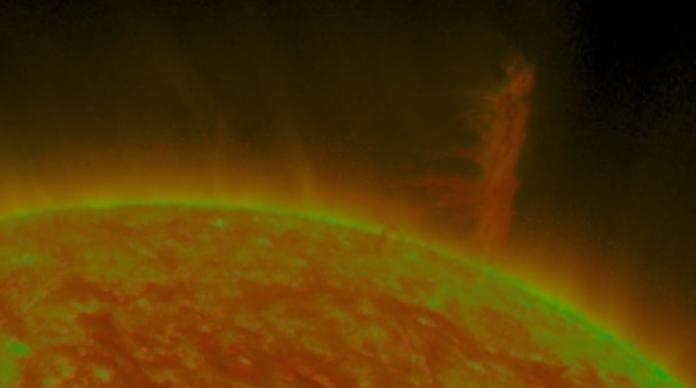NASA’s Solar Dynamics Observatory captured what might be ‘the tallest tornado’ in the solar system swirling across the north pole of the sun.
The twisting filament of boiling plasma kept growing in the sun’s atmosphere for three days last week, reaching the height of around 75,000 miles (120,000 kilometers), or 14 Earths, on Saturday (March 18), before collapsing into a cloud of magnetized gas. The collapse of the solar tornado ejected material from the sun’s atmosphere into the surrounding space, SpaceWeather (opens in new tab) reported, which, however, will not affect our planet.
Many amateur astronomers pointed their telescopes at the sun‘s north pole upon learning about the odd occurrence.
“This 14-Earths-tall swirling column of plasma was raining moon-sized gobs of incandescent material on the sun,” astrophotographer Andrew McCarthy tweeted (opens in new tab) on Saturday (March 18), sharing a sequence of his observations. “I can’t imagine a more hellish place,” he added.
Related: Strange unprecedented vortex spotted around the sun’s north pole
The sun has been fairly productive over the past days. The U.K. space weather forecaster Met Office described (opens in new tab) its activity as “moderate,” with six sunspots (darker, cooler areas of dense magnetic fields), currently visible on the star’s disk. The largest of these spots, which is located near the sun’s southeastern edge, may produce solar flares and plasma eruptions in the upcoming days, which could affect space weather around Earth, Met Office said,
In addition to that, two coronal holes — openings in the sun’s magnetic field — currently exist in the sun’s upper atmosphere (corona), spewing large quantities of speedy solar wind. This solar wind, a stream of magnetized gas, might trigger geomagnetic storms at Earth in the coming days when it interacts with the planet’s magnetic field. Met Office only expects a minor, G1 geomagnetic storm, but even that could be enough to supercharge aurora displays at higher latitudes.
Follow Tereza Pultarova on Twitter @TerezaPultarova (opens in new tab). Follow us on Twitter @Spacedotcom (opens in new tab) and on Facebook (opens in new tab).

